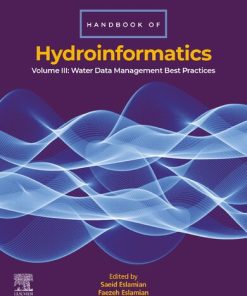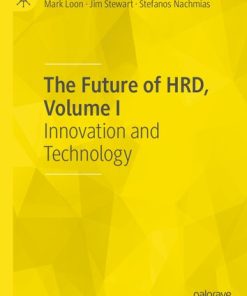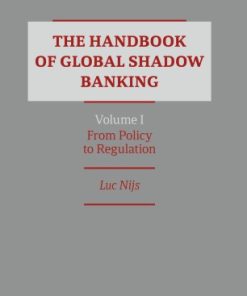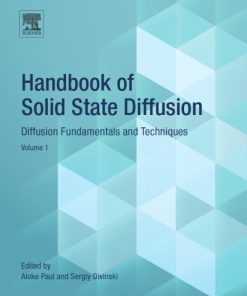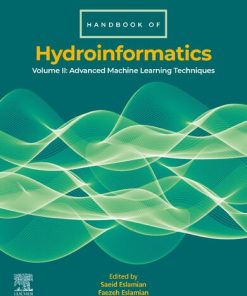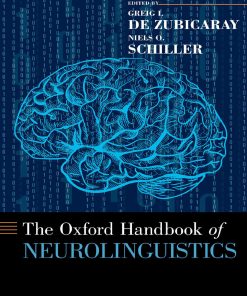(Ebook PDF) Handbook of HydroInformatics Volume I Classic Soft Computing Techniques 1st edition by Saeid Eslamian, Faezeh Eslamian 012821970X 9780128219706 full chapters
$50.00 Original price was: $50.00.$25.00Current price is: $25.00.
Handbook of HydroInformatics: Volume I: Classic Soft-Computing Techniques 1st edition by Saeid Eslamian, Faezeh Eslamian – Ebook PDF Instant Download/DeliveryISBN: 012821970X, 9780128219706
Full download Handbook of HydroInformatics: Volume I: Classic Soft-Computing Techniques 1st edition after payment.
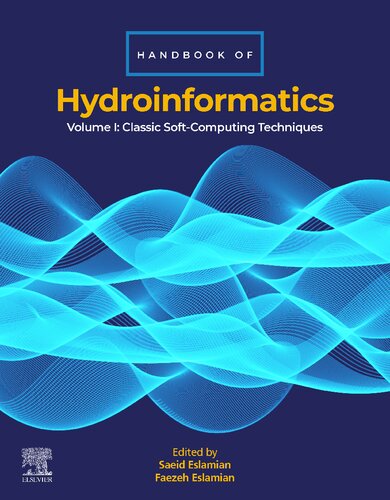
Product details:
ISBN-10 : 012821970X
ISBN-13 : 9780128219706
Author : Saeid Eslamian, Faezeh Eslamian
HydroInformatics series. Through this comprehensive, 34-chapters work, the contributors explore the difference between traditional computing, also known as hard computing, and soft computing, which is based on the importance given to issues like precision, certainty and rigor. The chapters go on to define fundamentally classic soft-computing techniques such as Artificial Neural Network, Fuzzy Logic, Genetic Algorithm, Supporting Vector Machine, Ant-Colony Based Simulation, Bat Algorithm, Decision Tree Algorithm, Firefly Algorithm, Fish Habitat Analysis, Game Theory, Hybrid Cuckoo–Harmony Search Algorithm, Honey-Bee Mating Optimization, Imperialist Competitive Algorithm, Relevance Vector Machine, etc.It is a fully comprehensive handbook providing all the information needed around classic soft-computing techniques.
Handbook of HydroInformatics: Volume I: Classic Soft-Computing Techniques 1st Table of contents:
Chapter 1: Advanced machine learning techniques: Multivariate regression
Abstract
1: Introduction
2: Linear regression
3: Multivariate linear regression
4: Gradient descent method
5: Polynomial regression
6: Overfitting and underfitting
7: Cross-validation
8: Comparison between linear and polynomial regressions
9: Learning curve
10: Regularized linear models
11: The ridge regression
12: The effect of collinearity in the coefficients of an estimator
13: Outliers impact
14: Lasso regression
15: Elastic net
16: Early stopping
17: Logistic regression
18: Estimation of probabilities
19: Training and the cost function
20: Conclusions
Appendix: Python code
References
Chapter 2: Bat algorithm optimized extreme learning machine: A new modeling strategy for predicting river water turbidity at the United States
Abstract
1: Introduction
2: Study area and data
3: Methodology
4: Results and discussion
5: Conclusions
References
Chapter 3: Bayesian theory: Methods and applications
Abstract
1: Introduction
2: Bayesian inference
3: Phases
4: Estimates
5: Theorem Bayes
6: Bayesian network
7: History of Bayesian model application in water resources
8: Case study of Bayesian network application in modeling of evapotranspiration of reference plant
9: Conclusions
References
Chapter 4: CFD models
Abstract
1: Introduction
2: Numerical model of one-dimensional advection dispersion equation (1D-ADE)
3: Physically influenced scheme
4: Finite Volume Solution of Saint-Venant equations for dam-break simulation using PIS
5: Discretization of continuity equation using PIS
6: Discretization of the momentum equation using PIS
7: Quasi-two-dimensional flow simulation
8: Numerical solution of quasi-two-dimensional model
9: 3D numerical modeling of flow in compound channel using turbulence models
10: Three-dimensional numerical model
11: Grid generation and the flow filed solution
12: Comparison of different turbulence models
13: Three-dimensional pollutant transfer modeling
14: Results of pollutant transfer modeling
15: Conclusions
References
Chapter 5: Cross-validation
Abstract
1: Introduction
2: Cross-validation
3: Computational procedures
4: Conclusions
References
Chapter 6: Comparative study on the selected node and link-based performance indices to investigate the hydraulic capacity of the water distribution network
Abstract
1: Introduction
2: Resilience of water distribution network
3: Hydraulic uniformity index (HUI)
4: Mean excess pressure (MEP)
5: Proposed measure
6: Hanoi network
7: Results and discussion
8: Conclusions
References
Chapter 7: The co-nodal system analysis
Abstract
1: Introduction
2: Co-nodal and system analysis
3: Paleo-hydrology and remote sensing
4: Methods
5: Nodes and cyclic confluent system
6: Three Danube phases
7: Danubian hypocycles as overlapping phases
8: Conclusions
References
Further reading
Chapter 8: Data assimilation
Abstract
1: Introduction
2: What is data assimilation?
3: Types of data assimilation methods
4: Optimal filtering methods
5: Auto-regressive method
6: Considerations in using data assimilation
7: Conclusions
References
Chapter 9: Data reduction techniques
Abstract
1: Introduction
2: Principal component analysis
3: Singular spectrum analysis
4: Canonical correlation analysis
5: Factor analysis
6: Random projection
7: Isometric mapping
8: Self-organizing maps
9: Discriminant analysis
10: Piecewise aggregate approximation
11: Clustering
12: Conclusions
References
Chapter 10: Decision tree algorithms
Abstract
1: Introduction
2: M5 model tree
3: Data set
4: Modeling and results
5: Conclusions
References
Chapter 11: Entropy and resilience indices
Abstract
1: Introduction
2: Water resource and infrastructure performance evaluation
3: Entropy
4: Resilience
5: Conclusions
References
Chapter 12: Forecasting volatility in the stock market data using GARCH, EGARCH, and GJR models
Abstract
1: Introduction
2: Methodology
3: Application and results
4: Conclusions
References
Chapter 13: Gene expression models
Abstract
1: Introduction
2: Genetic programming
3: Tree-based GEP
4: Linear genetic programming
5: Evolutionary polynomial regression
6: Multigene genetic programming
7: Pareto optimal-multigene genetic programming
8: Some applications of GEP-based models in hydro informatics
9: Conclusions
References
Chapter 14: Gradient-based optimization
Abstract
1: Introduction
2: Materials and method
3: Results and discussion
4: Conclusions
References
Chapter 15: Gray wolf optimization algorithm
Abstract
1: Introduction
2: Theory of GWO
3: Mathematical modeling of gray wolf optimizer
4: Gray wolf optimization example for reservoir operation
5: Conclusions
Appendix A: GWO Matlab codes for the reservoir example
References
Chapter 16: Kernel-based modeling
Abstract
1: Introduction
2: Support vector machine
3: Gaussian processes
4: Kernel extreme learning machine
5: Kernels type
6: Application of kernel-based approaches
7: Conclusions
References
Further reading
Chapter 17: Large eddy simulation: Subgrid-scale modeling with neural network
Abstract
1: Introduction
2: LES and traditional subgrid-scale modeling
3: Data-driven LES closures
4: Guidelines for SGS modeling
5: Conclusions
References
Chapter 18: Lattice Boltzmann method and its applications
Abstract
1: Introduction
2: Lattice Boltzmann equations
3: Thermal LBM
4: Multicomponent LBM (species transport modeling)
5: Flow simulation in porous media
6: Dimensionless numbers
7: Flow chart of the simulation procedure
8: Multiphase flows
9: Sample test cases and codes
10: Conclusions
Appendix A
Appendix B
References
Chapter 19: Multigene genetic programming and its various applications
Abstract
1: Introduction
2: Genetic programming and its variants
3: An introduction to multigene genetic programming
4: Main controlling parameters of MGGP
5: A review on MGGP applications
6: Future trends of MGGP applications
7: A case study of the MGGP application
8: Conclusions
References
Chapter 20: Ontology-based knowledge management framework in business organizations and water users networks in Tanzania
Abstract
1: Introduction
2: Theoretical framework
3: Empirical literature
4: Ontology-based knowledge management framework in business organizations: A conceptual framework
5: Ontology-based knowledge management framework in business organizations and water user networks proposed system
6: The practice of knowledge organization and expression
7: Conclusions
References
Chapter 21: Parallel chaos search-based incremental extreme learning machine
Abstract
1: Introduction
2: Materials and methods
3: Results and discussion
4: Conclusions
References
Chapter 22: Relevance vector machine (RVM)
Abstract
1: Introduction
2: Machine learning algorithms
3: Support vector machine
4: Relevance vector machine
5: Preprocessing step
6: Applications of relevance vector machine
7: Conclusions
References
Chapter 23: Stochastic learning algorithms
Abstract
1: Introduction
2: Gradient descent
3: Perceptron
4: Adaline
5: Multilayer network
6: Learning vector quantization
7: K-means clustering
8: Gradient boosting
9: Conclusions
References
Appendix A
Appendix B
Appendix C
Appendix D
Appendix E
Chapter 24: Supporting vector machines
Abstract
1: Introduction
2: SVMs for classification problems
3: SVMs for regression problems
4: Selection of SVM parameters
5: Application of support vector machines
6: Conclusions
References
Chapter 25: Uncertainty analysis using fuzzy models in hydroinformatics
Abstract
1: Introduction
2: Fuzzy logic theory
3: Concept of fuzzy uncertainty analysis
4: Uncertainty analysis applications
5: Machine learning and fuzzy sets
6: Fuzzy sets and probabilistic approach
7: Conclusions
References
Chapter 26: Uncertainty-based resiliency evaluation
Abstract
1: Introduction
2: Uncertainty analysis by the first-order method
3: Risk and resilience analysis
4: Reliability computation by direct integration
5: Reliability computation using safety margin/safety factor
6: Safety margin
7: Safety factor
8: Uncertainty-based hydraulic designs
9: Hydrologic uncertainties
10: Hydraulics uncertainties
11: Monte-Carlo uncertainty analysis in quasi-2D model parameters
12: SKM model
13: Uncertainty based river flow modeling with Monte-Carlo simulator
14: Monte-Carlo uncertainty analysis in machine learning techniques
15: Uncertainty evaluation using the integrated Bayesian multimodel framework
16: Copula-based uncertainty analysis
17: Uncertainty analysis with Tsallis entropy
18: Theory of evidence for uncertainty in hydroinformatics
19: Resiliency quantification
20: Conclusions
People also search for Handbook of HydroInformatics: Volume I: Classic Soft-Computing Techniques 1st:
handbook definition and examples
handbook of hydrology
handbook of hydraulic fluid technology
handbook of hydrogen energy
handbook of hydraulics
Tags:
Handbook,HydroInformatics,Soft Computing,Techniques,Saeid Eslamian,Faezeh Eslamian
You may also like…
Engineering
Uncategorized
Business & Economics
The Future of HRD, Volume I: Innovation and Technology 1st Edition
Business & Economics - Mathematical Economics
Spatial Economics, Volume I: Theory 1st ed. 2020 Edition Stefano Colombo
Business & Economics - Mathematical Economics




